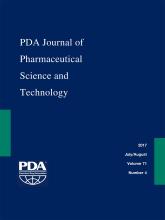Abstract
Terminal sterilization is considered the preferred means for the production of sterile drug products, as it affords enhanced safety for the patient because the formulation is sterilized in its sealed, final container. Despite the obvious patient benefits, the use of terminal sterilization is artificially constrained by unreasonable expectations for the minimum time-temperature process to be used. The core misunderstanding with terminal sterilization is the notion that destruction of a high population of a resistant biological indicator microorganism is required. More contemporary thinking on sterilization acknowledges that the bioburden is the actual target in sterilization and its destruction must be assured. In the application of low-temperature moist heat for terminal sterilization, especially subsequent to aseptic processing, establishing the pre-sterilization bioburden to consider has proven challenging. Environmental monitoring survey data has determined the identity of potential microorganisms but not their resistance to sterilization. This review article provides information on the moist heat resistance of vegetative and sporeforming microorganisms that might be present. The first paper in this series provided the overall background and described the benefits to patient, producer, and regulator of low-temperature moist heat for terminal sterilization. The second paper outlined validation and operational advice that can be used in the implementation. This final effort concludes the series and provides insight into potential bioburden and its resistance.
LAY ABSTRACT: Terminal sterilization is considered the preferred means for the production of sterile drug products as it affords enhanced safety for the patient as the formulation is filled into its final container, sealed and sterilized. Despite the obvious patient benefits, the use of terminal sterilization is artificially constrained by unreasonable expectations for the minimum time-temperature process to be used. The primary consideration in terminal sterilization is the reliable destruction of the bioburden. The earlier manuscripts in this series described the principles and implementation of low temperature terminal sterilization processes where the sterilization conditions would destroy the expected bioburden present. To accomplish that reliably knowledge of the bioburden expected resistance to moist heat is necessary. This review article will identify publications where that data can be found.
- Terminal sterilization
- Aseptic processing
- Sterilization
- Biological indicator
- Bioburden
- Probability of a non-sterile unit (PNSU)
- Regulation
- Sterility assurance
- © PDA, Inc. 2017
PDA members receive access to all articles published in the current year and previous volume year. Institutional subscribers received access to all content. Log in below to receive access to this article if you are either of these.
If you are neither or you are a PDA member trying to access an article outside of your membership license, then you must purchase access to this article (below). If you do not have a username or password for JPST, you will be required to create an account prior to purchasing.
Full issue PDFs are for PDA members only.
Note to pda.org users
The PDA and PDA bookstore websites (www.pda.org and www.pda.org/bookstore) are separate websites from the PDA JPST website. When you first join PDA, your initial UserID and Password are sent to HighWirePress to create your PDA JPST account. Subsequent UserrID and Password changes required at the PDA websites will not pass on to PDA JPST and vice versa. If you forget your PDA JPST UserID and/or Password, you can request help to retrieve UserID and reset Password below.






